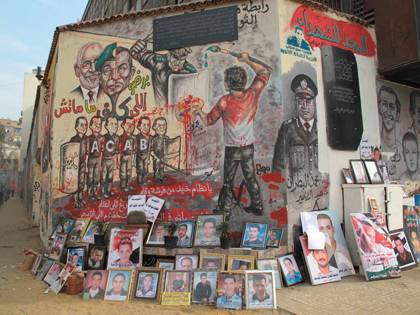
The dreams, hopes and anger of the Egyptian uprising after 2011 found their most direct and emotional expression through graffiti art, a Swedish journalist based in Cairo told a Duke audience Wednesday.
Mia Grondahl, who has lived in the Middle East since 1996 and has studied graffiti art throughout the region, said the work of the artists traced the spirit of the uprising and the conflicts that arose in its aftermath. (For a slideshow of some of her photos, click here.)
Through three decades of the Mubarak regime muzzling civil society, Egypt was mostly bereft of graffiti art, Grondahl said. But the uprising opened it to greater artistic and political expression.
"Graffiti in Tahrir Square was so new that when the uprising started, the artists first had to declare that their intentions were noble," said Grondahl, who spoke to a full room at the John Hope Franklin Center. "The first works dealt with Mubarak. To bring him down was enough," she said, showing a graffiti image of Mubarak aside the words, "Who protects the tyrants?"
In the first days of the uprising, much of the art showed cries for freedom and unity. Many of the works depicted the breaking of shackles or Christians and Muslims working together.
"The artists portrayed the pride to be an Egyptian," Grondahl said. "After the uprising, Egyptians felt they finally could be proud again to be Egyptian. Previously, they were ashamed especially because of Mubarak's foreign policy."
Much of the art referenced images from Egypt's history. Although Mubarak was often referred to as a pharaoh, images of pharaohs were common as artists saw the revolution as a return to the country's glorious past.
But through 2011 and 2012, as the new military rulers and political elites broke many of their promises, other themes emerged. One of the most emotional works of graffiti art was a memorial to the 79 soccer fans killed during a soccer riot in Port Said. Many blamed security forces for failing to keep order during the riot.
Grondahl said she regularly visited the memorial and saw the effect the artists had. "With a couple of strokes, these artists brought out the life of these martyrs. Teams of artists worked on them for weeks, and more and more elements were added," she said. "People came and laid flowers at the wall, and I saw mothers be overcome at the sight of their son. The message the artists told was that Egyptians carry a great, proud heritage: Islamic, Coptic, Greco-Roman, it was all part of who we are."
She added that the graffiti art became battlegrounds of sorts. One portrait of a tank facing off against bicyclist carrying a loaf of bread balanced on his head -- a common Cairo sight -- attracted attention. First a team of artists added rows of protesters.
After security forces killed peaceful protesting Christians in Maspero, Egypt, one artist added the protesters being crushed by the tank.
But then pro-military artists came and erased the protesters and turned the message into one supporting the army. The original artists returned days later to paint an army of monster soldiers eating the protesters.
"We would go every weekend to this wall just to see what was going to happen next," Grondahl said.
Grondahl's photos of the Egyptian graffiti art is collected in "Revolution Graffiti: Street Art of the New Egypt."
Her talk was sponsored by the Duke Middle East Studies Center, the Center for Global Studies and the Humanities, Duke Human Rights Center at the Franklin Humanities Institute, Duke Islamic Studies Center and the John Hope Franklin Center. Grondahl's photos of Egyptian street art are on exhibit in the John Hope Franklin Center gallery until Oct. 11.